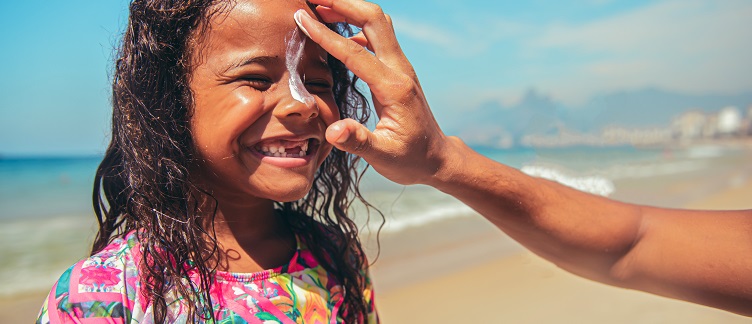Although it’s pleasant when you first experience sun warming your skin, over time the sun causes damage to your skin.
Sun damage can make itself visible in a number of ways — from premature aging and discoloration of the skin (sometimes called sunspots) to, in more severe cases, skin cancer and melanoma. Sun damage is caused by ultraviolet radiation:
What is Ultraviolet Radiation?
Ultraviolet (UV) radiation is invisible rays that are part of the energy that comes from the sun. There are three types of UV radiation – UVA, UVB, and UVC.
UV rays are measured by a numbered index. Local news and weather channels will tell you what the level is expected to reach each day:
|
0-2: Low risk Sunscreen Sunglasses |
3-5: Medium risk Sunscreen Sunglasses Hat |
|
6-7: High risk Sunscreen Sunglasses Hat Shade |
7-10: Very high risk Sunscreen Sunglasses Hat Shade |
|
11+: Extreme risk Sunscreen Sunglasses Hat Shade Stay indoors, especially from 10 a.m. to 4 p.m. |
|
Never Miss a Beat!
Subscribe to Our HealthBeat Newsletter!
Thank you for subscribing!
You can now select the specific newsletters you'd like to receive.
You are already subscribed.
Subscribe to more newsletters in our email preference center.
Sorry, an error occurred. Please try again later.
Get Healthy Tips Sent to Your Phone!
Why Is It Important to be Protected?
UV radiation, in all of its forms, can cause:
- Melanoma and several other types of skin cancers.
- Sun damage that prematurely ages the skin.
- Premature aging.
- Eye damage.
- Altered function of the immune system.
When Is the Most Dangerous Time for UV Exposure or Sun Damage?
Most of the day’s UV rays from the sun come between 9 a.m. and 5 p.m., and almost a third of the day’s rays come between 11 a.m. and 1 p.m., according to the American Cancer Society. UV rays are dangerous throughout the year, but they are the strongest during the summer.
Where Does UV Radiation Come From and Where Should I Be Protected?
UV radiation comes mostly from the sun and tanning beds. You may also be exposed to UV radiation via special lamps or lasers that are used to treat skin conditions, such as psoriasis.
Any part of your skin that is exposed to the sun should be protected by:
- Wearing sunscreen with at least an SPF of 30.
- Seeking shade.
- Wearing protective clothing (hat and sunglasses).
Who Is most Affected by UV Exposure?
Everyone should be protected from UV exposure.
Sunscreen should especially be applied to children and parents should also consider protective clothing for little ones spending time in the sun.
Babies younger than six months should be protected using hats and clothing and should be kept out of direct sunlight. Only use sunscreen on small areas that are exposed if shade or clothing is not available.
If you have a sunspot or mole that looks unusual, you may want to have it looked at to be sure it is benign. Please visit the UPMC Hillman Cancer Center website and request an appointment online or call 412-647-2811.
Editor's Note: This article was originally published on , and was last reviewed on .
About UPMC Hillman Cancer Center
When you are facing cancer, you need the best care possible. UPMC Hillman Cancer Center provides world-class cancer care, from diagnosis to treatment, to help you in your cancer battle. We are the only comprehensive cancer center in our region, as designated by the National Cancer Institute. We have more than 70 locations throughout Pennsylvania, Ohio, and New York, with more than 200 oncologists – making it easier for you to find world-class care close to home. Our internationally renowned research team is striving to find new advances in prevention, detection, and treatment. Most of all, we are here for you. Our patient-first approach aims to provide you and your loved ones the care and support you need. To find a provider near you, visit our website.
